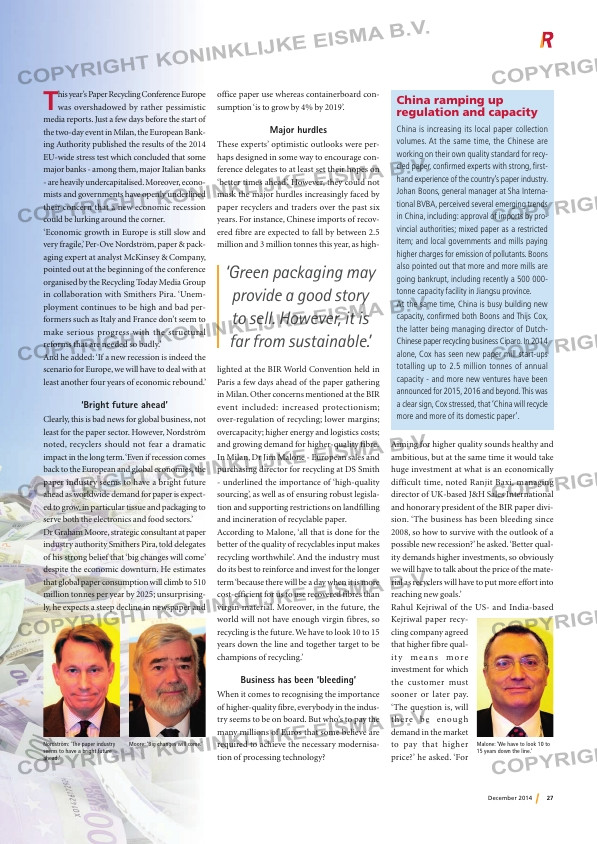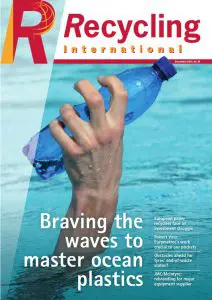Page 27 from: December 2014

27December 2014
Aiming for higher quality sounds healthy and
ambitious, but at the same time it would take
huge investment at what is an economically
difficult time, noted Ranjit Baxi, managing
director of UK-based J&H Sales International
and honorary president of the BIR paper divi-
sion. ‘The business has been bleeding since
2008, so how to survive with the outlook of a
possible new recession?’ he asked. ‘Better qual-
ity demands higher investments, so obviously
we will have to talk about the price of the mate-
rial as recyclers will have to put more effort into
reaching new goals.’
Rahul Kejriwal of the US- and India-based
Kejriwal paper recy-
cling company agreed
that higher fibre qual-
i t y means more
investment for which
the customer must
sooner or later pay.
‘The question is, will
there be enough
demand in the market
to pay that higher
price?’ he asked. ‘For
This year’s Paper Recycling Conference Europe was overshadowed by rather pessimistic
media reports. Just a few days before the start of
the two-day event in Milan, the European Bank-
ing Authority published the results of the 2014
EU-wide stress test which concluded that some
major banks – among them, major Italian banks
– are heavily undercapitalised. Moreover, econo-
mists and governments have openly underlined
their concern that a new economic recession
could be lurking around the corner.
‘Economic growth in Europe is still slow and
very fragile,’ Per-Ove Nordström, paper & pack-
aging expert at analyst McKinsey & Company,
pointed out at the beginning of the conference
organised by the Recycling Today Media Group
in collaboration with Smithers Pira. ‘Unem-
ployment continues to be high and bad per-
formers such as Italy and France don’t seem to
make serious progress with the structural
reforms that are needed so badly.’
And he added: ‘If a new recession is indeed the
scenario for Europe, we will have to deal with at
least another four years of economic rebound.’
‘Bright future ahead’
Clearly, this is bad news for global business, not
least for the paper sector. However, Nordström
noted, recyclers should not fear a dramatic
impact in the long term. ‘Even if recession comes
back to the European and global economies, the
paper industry seems to have a bright future
ahead as worldwide demand for paper is expect-
ed to grow, in particular tissue and packaging to
serve both the electronics and food sectors.’
Dr Graham Moore, strategic consultant at paper
industry authority Smithers Pira, told delegates
of his strong belief that ‘big changes will come’
despite the economic downturn. He estimates
that global paper consumption will climb to 510
million tonnes per year by 2025; unsurprising-
ly, he expects a steep decline in newspaper and
office paper use whereas containerboard con-
sumption ‘is to grow by 4% by 2019’.
Major hurdles
These experts’ optimistic outlooks were per-
haps designed in some way to encourage con-
ference delegates to at least set their hopes on
‘better times ahead’. However, they could not
mask the major hurdles increasingly faced by
paper recyclers and traders over the past six
years. For instance, Chinese imports of recov-
ered fibre are expected to fall by between 2.5
million and 3 million tonnes this year, as high-
lighted at the BIR World Convention held in
Paris a few days ahead of the paper gathering
in Milan. Other concerns mentioned at the BIR
event included: increased protectionism;
over-regulation of recycling; lower margins;
overcapacity; higher energy and logistics costs;
and growing demand for higher-quality fibre.
In Milan, Dr Jim Malone – European sales and
purchasing director for recycling at DS Smith
– underlined the importance of ‘high-quality
sourcing’, as well as of ensuring robust legisla-
tion and supporting restrictions on landfilling
and incineration of recyclable paper.
According to Malone, ‘all that is done for the
better of the quality of recyclables input makes
recycling worthwhile’. And the industry must
do its best to reinforce and invest for the longer
term ‘because there will be a day when it is more
cost-efficient for us to use recovered fibres than
virgin material. Moreover, in the future, the
world will not have enough virgin fibres, so
recycling is the future. We have to look 10 to 15
years down the line and together target to be
champions of recycling.’
Business has been ‘bleeding’
When it comes to recognising the importance
of higher-quality fibre, everybody in the indus-
try seems to be on board. But who’s to pay the
many millions of Euros that some believe are
required to achieve the necessary modernisa-
tion of processing technology?
‘Green packaging may
provide a good story
to sell. However, it is
far from sustainable.’
China ramping up
regulation and capacity
China is increasing its local paper collection
volumes. At the same time, the Chinese are
working on their own quality standard for recy-
cled paper, confi rmed experts with strong, fi rst-
hand experience of the country’s paper industry.
Johan Boons, general manager at Sha Interna-
tional BVBA, perceived several emerging trends
in China, including: approval of imports by pro-
vincial authorities; mixed paper as a restricted
item; and local governments and mills paying
higher charges for emission of pollutants. Boons
also pointed out that more and more mills are
going bankrupt, including recently a 500 000-
tonne capacity facility in Jiangsu province.
At the same time, China is busy building new
capacity, confi rmed both Boons and Thijs Cox,
the latter being managing director of Dutch-
Chinese paper recycling business Ciparo. In 2014
alone, Cox has seen new paper mill start-ups
totalling up to 2.5 million tonnes of annual
capacity – and more new ventures have been
announced for 2015, 2016 and beyond. This was
a clear sign, Cox stressed, that ‘China will recycle
more and more of its domestic paper’.
Malone: ‘We have to look 10 to
15 years down the line.’
Moore: ‘Big changes will come.’Nordström: ‘The paper industry
seems to have a bright future
ahead.’
RI-10 Paper.indd 27 04-12-14 14:32



